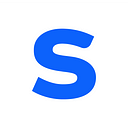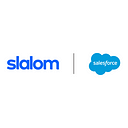An Architect’s Guide to TrailblazerDX
A Q&A with Slalom’s Salesforce Experience Cloud leader
Do you want to get inside the head of a Salesforce Architect and are hoping for tips on how to make the most out of your TrailblazerDX 2023 experience?
We’ve gathered insights from Tyler Ochsner — leader of the Salesforce Experience Cloud capability at Slalom and a seasoned systems and solutions architect with more than 10 years of experience designing and implementing technology solutions across numerous industries.
A few of Tyler’s certifications include:
- Salesforce Certified System Architect and Application Architect
- Salesforce Certified Experience Cloud Consultant
- Salesforce User Experience Designer
Let’s meet Tyler!
Mariel: Tyler, you’re a seasoned architect who achieved multiple architect certifications last year (Data Architect, Development, Lifecycle and Deployment Architect, System Architect, and Sharing and Visibility Architect). How did you get started in Salesforce?
Tyler: I started off my career as an investment banker, then volunteered as a domestic violence probation officer for a municipal court to use my degree. I moved on to work with Homeland Security and eventually pivoted to working at Zillow doing Finance.
I wanted to automate my job at Zillow because I was managing multiple Excel sheets, Outlook email templates, and updating Salesforce. I knew there had to be a better way of working, so I figured out how to use Salesforce to turn an operations bill collection process (which usually took 4–6 hours per day for three people) into a 10-minute, automated process for one person. I taught myself how to do this pre-Trailhead by reading physical books and PDFs online, but mostly by tinkering with the platform to understand how it worked. After this job, I moved into Salesforce consulting.
Mariel: As a two-time TrailblazerDX attendee, what advice would you give to other Salesforce architects looking to tackle certifications at the conference?
Tyler: Don’t be afraid to ask questions. Connect with your instructor and your fellow attendees. Developing connections with people will help you all understand the content better. Attend the study halls. It’s a great place to meet people in your cohort and talk about the content being presented, plus the instructor or instructor’s assistant is there to help answer questions. I also recommend taking physical notes during the sessions — that has helped me retain information better.
Mariel: How did you leverage the bootcamp opportunities at the conference?
Tyler: In 2019, I attended an Integration Architect Bootcamp (previously called System Architect Bootcamp) which focused on integrations and authentication. I prepared for the bootcamp ahead of time by memorizing integration patterns and different authentication methods and when best to use them.
My strategy going into the bootcamp was to take the certification test on the Monday before the conference to familiarize myself with the types of questions on the exam. I then took the bootcamp at TrailblazerDX and used the free certification voucher Salesforce offers to every attendee to take the test.
Mariel: What sessions are you most excited to take this year?
Tyler: I’m excited to attend any sessions that cover Lightning Web Runtime because that’s where all the new innovations are happening. I love front-end and user-centric digital experiences, and I’m excited to hear what else is being created by Salesforce to build these great customer-focused designs.
I’m also excited about Salesforce CMS because it’s continuing to evolve and become a more robust content management system to create consumer-grade websites.
Mariel: What sessions do you recommend other Salesforce Architects attend?
Tyler: After scoping out the sessions being offered at TDX, I picked the following sessions because deployment and source-control procedures are often overlooked and highly important to project success. Some projects have a lot of features, and manual testing can become a huge burden, so it’s good to factor in automated testing. Building solutions that scale and don’t introduce technical debt are important because often teams don’t address the technical debt that’s introduced to meet timelines or update existing features to leverage more elegant and less code-based solutions.
Also, security should always be a top priority for everyone, so keeping up to date with the recommended approach for user permissions is something I would recommend.
Mariel: What Salesforce certifications are you looking to take next?
Tyler: This year, I’m planning to go for the Salesforce Certified Marketing Cloud Administrator and the Salesforce Marketing Cloud Personalization Accredited Professional credentials. I’m interested in getting closer to the details of creating personalized digital experiences and using the information we have about a person to create engaging experiences when they aren’t on the site.
If you’re a Salesforce architect on a similar path, I’d love to meet you at TrailblazerDX. Connect with me on LinkedIn and find me at Slalom’s booth in the Trailblazer Forest in Moscone West.
TrailblazerDX is now open for registrations! Join Tyler and other trailblazers from Slalom on March 7th and 8th and learn from over 250 sessions in San Francisco and Salesforce+.
Slalom is a global consulting firm that helps people and organizations dream bigger, move faster, and build better tomorrows for all. Learn more and reach out today.

